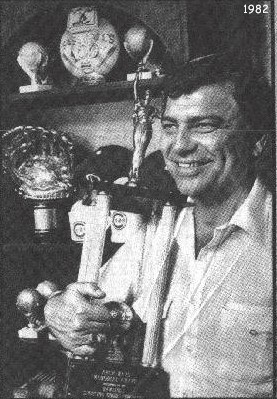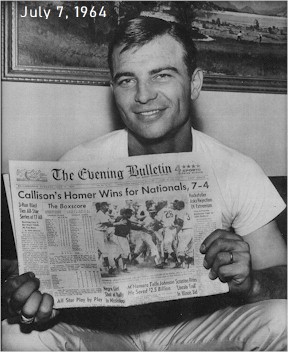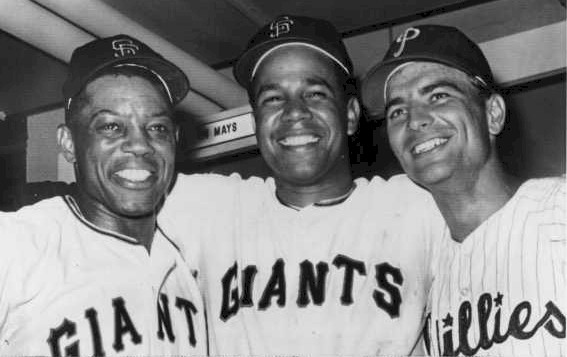Johnny Callison's
Memorable Moment
----------------------------------
A dramatic game-winning home run in the ninth inning in 1964 is the biggest
All-Star Game feat performed by a Phillie.
By DON BOSTROM (July 1996)
PHILADELPHIA
(1996)- When it comes to stealing the show in
the All-Star Game, the Phillies are batting 1-for-66. But, oh, what a glorious,
majestic hit the one was. Johnny Callison's three-run home run off Boston's Dick
Radatz in the bottom of the ninth inning to win the 1964 All-Star Game at Shea Stadium 7-4
on July 7 is the signature All-Star moment in Phillies history. That swing was also
the defining moment in Callison's often distinguished, sometimes checkered major league
career. It was his Andy Warhol moment, except that those 15 minutes of fame had
quite a shelf life...32 years, with no signs of fading away.
In fact, that homer off Radatz seems like only yesterday to
Callison because not a day goes by that he doesn't relive it for some adoring fan.
Callison, like Bill Murray in "Groundhog Day," repeats the same sequence of
events, day after day after day. "I've seen that movie and I can relate to it a
lot," Callison chuckled. "Every day someone tells me about it. Good
thing, too, because at my age (57), I'm having trouble remembering what really
happened.". |

|
There are reasons Callison's
homer is frozen in time. Specifically, 1964 was the enchanted summer for Phillies
baseball fans. While teen-age girls were being bitten by Beatlemania, teen-age boys
in Philadelphia were going "Yeah! Yeah! Yeah!" to the exploits of a Gene Mauch
team that was taking the National League by storm. Folks began to realize something
extraordinary was taking place when Hall of Fame pitcher Jim Bunning fired his perfect
game at Shea Stadium on Father's Day. Callison's All-Star heroics only bolstered the
notion that the Phillies were destiny's darlings. "That homer was the greatest
thrill of my life, but I remember thinking that it was only the beginning. It was
going to be the Phillies' year," Callison said. "We had everything going
our way. Everything."
Anyone who followed the Phillies that season still bears the
scars of the greatest collapse in history. How could a 6 1/2-game lead vanish in the
final 12 games? That question has haunted Phillies fans ever since. Perhaps
that's one reason fans cling so dearly to the positive vibes created by the Callison
homer.
An amazing chain of events took place to enable Callison to be at
the right place at the right time. His joy at being named to the All-Star team was
tempered by the fact that Richie Allen was left off. Allen was in the midst of a
rookie season that would see him lead the NL with 125 runs scored, collect 201 hits, slug
29 homers, 38 doubles, 13 triples and drive in 91 runs. "Richie should have
made the team. He should have started at third base instead of Kenny Boyer,"
Callison said.
Callison sat on the bench while Walter Alston used a Hall of
Fame-bound outfield of Willie Mays, Roberto Clemente and Billy Williams. Callison
entered the game, ironically, as a pinch-hitter for Bunning in the bottom of the fifth.
He popped out against Washington Senators ace Camilo Pascual. "I thought
I was done," Callison said. "I was surprised when Alston left me in to
play right field." The surprise was genuine because Alston still had Hank Aaron
riding the pine. "Aaron was sick. That's the only reason I got in,"
Callison said.
The American League took a 4-3 lead in the seventh inning when
Jim Fregosi hit a sacrifice fly to knock in Brooks Robinson. AL skipper Ralph Houk
put the ball in the hands of Radatz, the famed "Monster," an imposing 6-foot-6,
250-pound side-armer who was averaging two strikeouts per inning that season. Few
people recall that Callison batted against Radatz in the seventh. "I tagged one
pretty good then, too," Callison said. "When I hit it, I thought it had a
chance. But Mickey Mantle caught it in deep right-center." The game's
entire complexion changed in the bottom of the ninth when plate umpire Ed Sudol gave Mays
a break on a nasty 2-2 slider. Radatz said during an Old-Timer's Game here a few
years ago that that pitch was really the ballgame. "I had him struck out,"
Radatz said. "Willie knew it, too. He was walking back to the
dugout." When Mays walked, Radatz admitted, "I got unnerved. New
York was Willie's town and the place got electric." Mays stole second, Orlando
Cepeda blooped a single to right, and Mays dashed home when Joe Pepitone's throw to the
plate bounced past catcher Elston Howard. With the score tied, Radatz regrouped.
He got Boyer to pop up, intentionally walked Doc Edwards and then struck out the
ailing Aaron with three searing fastballs. Callison was next.
"He really hummed them past Hank. I also remember how
hard he threw in the seventh," Callison said. "So, I decided to switch to
a lighter bat. I borrowed one from Billy Williams." Williams promised
Callison the bat for a long time before donating it to the Hall of Fame in Cooperstown,
NY. "I don't think I'll get it now," Callison said. "That's
where it belongs so everyone can enjoy it. They've got a nice display with a
write-up of the whole thing." Callison still has the home run ball, although
it's got a nice set of teeth marks in it. During a playful moment, Inga, his German
Shepherd, jumped up on the trophy case and tore into the treasure. You can also see
the welt from the blow Callison delivered on the first pitch he saw from "The
Monster." "Stayed fair by 10 feet," Callison said. "I
floated around the bases." The blast earned Callison a hero's welcome at the
plate from nine future Hall of Famers.
Again, he thought, it was only the beginning. Callison
would have been the NL MVP in 1964 if the Phillies had held on. He hit .274 with 31
homers and 101 RBIs. He played a marvelous right field. If...
"Yeah, 1964 was two weeks too long," Callison said. "But that's
another story."
When Callison retired from baseball, he still couldn't escape the
events of July 7. It made for a natural conversation piece in stints as a bartender
and car salesman. "Everybody remembers where they were or what they were doing
that day. I've heard some good stories." Callison said. "Every year,
around the All-Star game, I get some phone calls from reporters," Callison said.
"It's been really hectic this year because the game is in Philadelphia.
I've had all the TV stations out to my house (In Glenside)."
Callison has overcome failing health a few years ago and is
enjoying retirement. He shattered a shin bone last year when he stumbled on a curb.
The bone healed short, so he walks with a slight limp. But that won't hurt
him tomorrow or the day after when he takes another home run trot after taking "The
Monster" deep. Again. For the millionth time. "Dick and I have
become good friends," Callison said. "He teases me all the time that
I was a nobody until he made me. I tell him no one would remember him, either, if it
weren't for me." Callison said the All-Star homer will never wear him down.
"It's not tiresome," Callison said. "I'm just glad people
remember me for something." |






